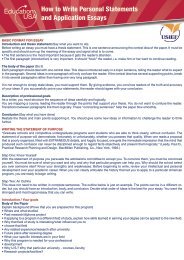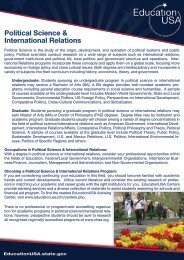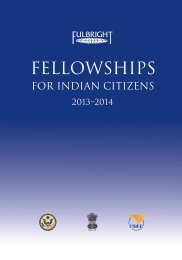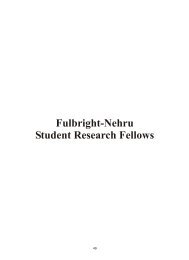FULBRIGHT-HAYS SEMINARS ABROAD PROGRAM - USIEF
FULBRIGHT-HAYS SEMINARS ABROAD PROGRAM - USIEF
FULBRIGHT-HAYS SEMINARS ABROAD PROGRAM - USIEF
You also want an ePaper? Increase the reach of your titles
YUMPU automatically turns print PDFs into web optimized ePapers that Google loves.
<strong>FULBRIGHT</strong>-<strong>HAYS</strong> <strong>SEMINARS</strong> <strong>ABROAD</strong> <strong>PROGRAM</strong><br />
Independent/Curriculum Project Guidelines<br />
Fulbright-Hays Seminars Abroad Program participants are required to develop curriculum units.<br />
When completing the required project, please keep in mind that this project should be something<br />
which can be used by the participant's institution and/or community which educates about aspects of<br />
the host country(ies) of the particular seminar in which you participated. Additionally, the curriculum<br />
project that you create will serve as a valuable resource for other educators who do not have the<br />
opportunity to participate in such a program. The following is a general description of this project<br />
requirement and its purpose.<br />
WHAT IS REQUIRED?<br />
It is recognized that a curriculum unit is determined by the audience, level and/or complexity of the<br />
lesson plan, and the person/organization that approves curricula. The required project applies to all<br />
participants, regardless of teaching level. It is understood, however, that at the college or university<br />
level, different types of curriculum-based projects may be more appropriate than curriculum units.<br />
Please do not submit a collection of images with text. The project can focus on a particular image or<br />
series of images, however there needs to be a lesson developed around the images.<br />
This guideline focuses primarily on the curriculum projects. However, many of the details regarding<br />
expectations apply to all levels of work.<br />
WHY DOES THE REQUIREMENT EXIST?<br />
The independent/curriculum project is a mandatory part of the seminar experience for a number of<br />
reasons. First among these is the role as a focusing agent for the participants in the seminar. The<br />
project serves to filter and define the vast quantity of information presented during the seminars into a<br />
useful tool. Second, the projects are used to expand the impact of the seminars. The finished work<br />
becomes available through application in the participants' classrooms, in institutions, schools, and<br />
communities, and through presentations at professional associations. Third, completed curriculum<br />
projects will be posted on Fulbright Commission or other education association websites, whenever<br />
possible, to serve both as an example for future Seminars Abroad program applicants as well as a<br />
reference tool for educators nationwide. Therefore, the completion of the independent/curriculum<br />
project is a very significant part of the participant’s seminar experience.<br />
HOW ARE THE PROJECTS USED?<br />
All participants are required to complete one curriculum or independent project which is relevant to<br />
their teaching or administrative responsibilities. The project will be coordinated, assisted, and<br />
collected by the administering agency of the seminar. In the case where two administering agencies<br />
are involved with a joint seminar, the agencies will decide which one will be responsible for<br />
coordinating the collection of the projects. Participants are required to submit their projects to the<br />
coordinating administering agency 90 days after the end date of the seminar.<br />
During the seminar, the agency will use its discretion in facilitating projects based on how much each<br />
participant is able to do within the context of the seminar. Each completed project will be submitted<br />
by the participant to the administering agency, along with a summary page. If the administering<br />
agency has the capability, it will also post completed projects on the web.
WHAT IS THE TIMETABLE?<br />
The following are suggestions on how to maximize the time available before, during, and after the<br />
seminar to complete the best project possible.<br />
Before Departure:<br />
Participants should ask themselves three essential questions to help develop their project’s focus:<br />
• What do U.S. students need to know about the host country(ies)?<br />
• Why is knowledge about the host country(ies) important for U.S. students?<br />
• How can I facilitate learning about the host country(ies)?<br />
Following are suggestions for further formulating project ideas:<br />
Search for existing curricula about the culture of the host country to be studied. Local libraries, school<br />
libraries, university specialists and U.S. Department of Education-funded Title VI National<br />
Resource Centers are good places to begin (http://www.ed.gov/programs/iegpsnrc/index.html;<br />
go to Awards);<br />
Find out what your students want to know, or already know about the host country; consider planning<br />
a global, regional, or cross-cultural lesson which includes information about the host country.<br />
For example, Mexico’s economy could be studied in terms of Latin America's overall economy;<br />
or a religious artifact from India could introduce students to religions of Asia;<br />
Decide how the revised or new curriculum units will be incorporated into current courses;<br />
Check with former seminar participants about curriculum projects and resources<br />
Identify specific topics so that purchases, taping and photographic efforts are focused, saving time<br />
and money;<br />
Confer with other faculty and colleagues about needs across other disciplines; possibly outline an<br />
interdisciplinary approach and/or curriculum.<br />
In Country:<br />
During the seminar abroad, participants should:<br />
1. Gather materials and artifacts that are representative of the culture, its geography, or history.<br />
Samples might include photographs, slides and videotapes of the terrain, buildings, people,<br />
advertisements, and television shows; commercial pictures; flyers, brochures, product<br />
packaging wrappers, fast food or entertainment posters; money and stamps; clothing; toys<br />
and games, maps made in the country; audio tapes of music, magazines, books, and<br />
textbooks for the grade level taught at home; and newspapers;<br />
2. Compile notes from interviews, lectures, briefings, and tours; and other information gathering<br />
opportunities;<br />
3. Arrange conversations and interviews with citizens of different ages and backgrounds, if<br />
feasible;<br />
4. Check with the group leader/coordinator and other members of the seminar for ideas and<br />
possible revisions of the curriculum units. You may find that your originally planned topic<br />
may have to be refocused once you are in the host country(ies). You must be mindful<br />
about how feasible your project is in the context of the seminar and which resources<br />
are (or are not) available in the host country(ies); and<br />
5. View text materials of the host country on subjects appropriate to the level taught; talk with<br />
teachers in the host country, if possible.<br />
- 2 -
Upon Return:<br />
Participants should consider a review of the curriculum projects with other participants in the host<br />
country, and a follow-up debriefing in the U.S. whenever possible. Many participants generally attend<br />
annual meetings of the National Council for the Social Studies or other professional meetings. These<br />
opportunities provide ideal fellowship since the U.S. Department of Education cannot cover such<br />
costs. This will facilitate the sharing of lesson plans, tapes, slides, photocopies, and other materials.<br />
In addition, it is suggested that you:<br />
1. Secure/protect flyers, brochures, maps and other paper materials;<br />
2. Document all slides, tapes and artifacts;<br />
3. Review notes and materials, including both personal and handouts; and<br />
4. Prepare a plan to teach a lesson from the curriculum unit as a result of the seminar abroad as<br />
early in the school year as possible.<br />
A NOTE ABOUT COPYRIGHTS & DISSEMINATION:<br />
Please be sure to cite all other sources’ published materials that you include in your project.<br />
When using other sources, you are required to receive permission to use the material from the owner<br />
of that material’s copyright. Fulbright-Hays participants are not exempt from fees or penalties incurred<br />
for illegally using copyrighted materials.<br />
Also, please keep in mind that participants are free to pursue copyrights on their<br />
curriculum/independent projects. However, it should be noted that any materials developed under the<br />
auspices of the Fulbright-Hays program should be available to the public at no cost.<br />
In addition, participants are required to share their projects with colleagues and conduct outreach<br />
activities in their institutions, schools, classrooms, and communities upon return to the U.S. and may<br />
be asked to submit a detailed dissemination report on how this was accomplished.<br />
Please remember that the project is to be shared. Include all pertinent materials to make the<br />
project as inclusive as possible.<br />
Below we are including a guideline for creating a curriculum unit; this is borrowed from Understanding<br />
by Design Professional Development Workbook. If you do not have much experience in developing<br />
curriculum we strongly recommend getting this workbook. Our office strongly recommends using this<br />
format for developing the curriculum unit.<br />
- 3 -
Stage 1- Desired Results<br />
Established Goals<br />
• What relevant goals (e.g., content standards, course or program objectives, learning<br />
outcomes) will this design address?<br />
Understandings:<br />
Students will understand that…<br />
• What are the big ideas?<br />
• What specific understandings about<br />
them are desired?<br />
• What misunderstandings are<br />
predictable?<br />
Essential Questions<br />
• What provocative questions will foster<br />
inquiry, understanding and transfer of<br />
learning?<br />
Students will know…<br />
Students will be able to….<br />
• What key knowledge and skills will students acquire as a result of this unit?<br />
• What should they eventually be able to do as a result of such knowledge and skill?<br />
Stage 2- Assessment Evidence<br />
Performance Tasks:<br />
• Through what authentic performance<br />
tasks will students demonstrate the<br />
desired understandings?<br />
• By what criteria will performance of<br />
understanding be judged?<br />
Other Evidence:<br />
• Through what other evidence (e.g., quizzes,<br />
tests, academic prompts, observations,<br />
homework journals) will students<br />
demonstrate achievement of the desired<br />
results?<br />
• How will students reflect upon and selfassess<br />
their learning?<br />
Stage 3- Learning Plan<br />
Learning Activities:<br />
What learning experiences and instruction will enable students to achieve the desired results?<br />
How will the design-<br />
W = Help the students know Where the unit is going and What is expected? Help the teacher<br />
know Where<br />
the students are coming from (prior knowledge, interests)?<br />
H = Hook the students and Hold their interest?<br />
E = Equip students, help them Experience the key ideas and Explore the issues?<br />
R = Provide opportunities to Rethink and Revise their understandings and work?<br />
E = Allow students to Evaluate their work and its implications?<br />
T = Be Tailored (personalized) to the different needs, interests and abilities of learners?<br />
O = Be Organized to maximize initial and sustained engagement as well as effective learning?<br />
Curriculum Quicksheet<br />
- 4 -







